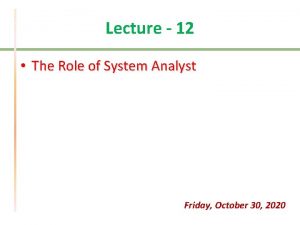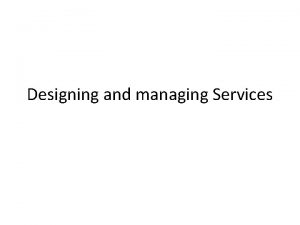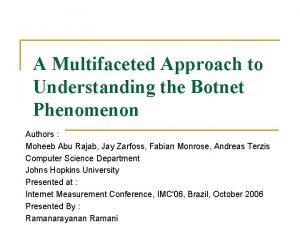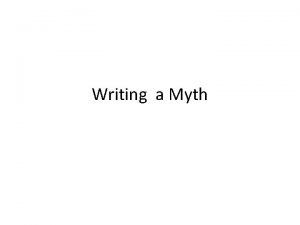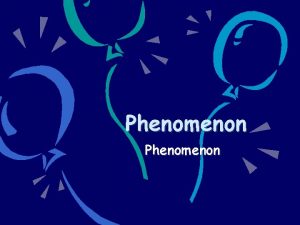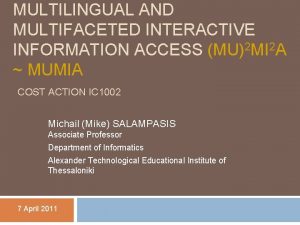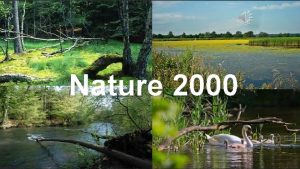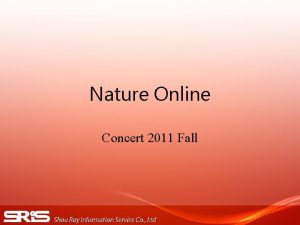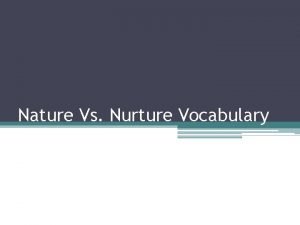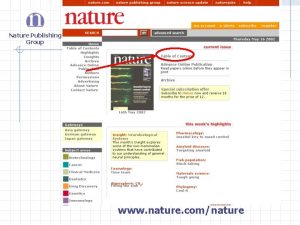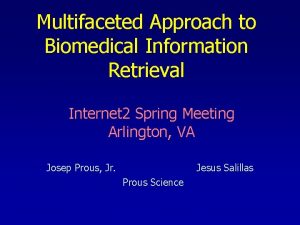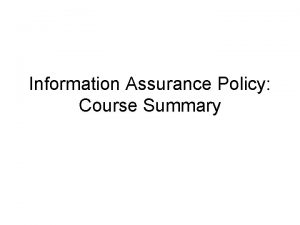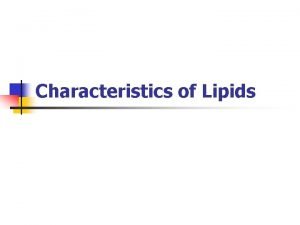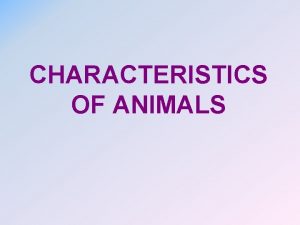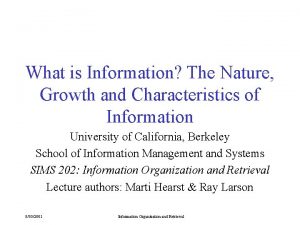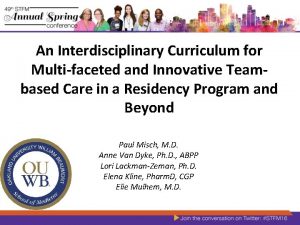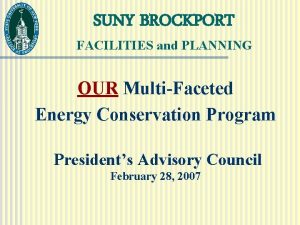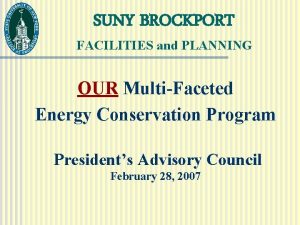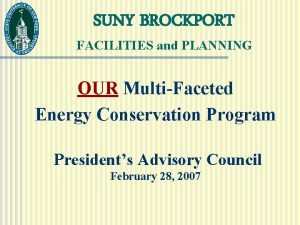The phenomenon of INFORMATION Nature and multifaceted characteristics
































- Slides: 32

The phenomenon of INFORMATION Nature and multifaceted characteristics Tefko Saracevic Rutgers University © Tefko Saracevic 1

What is information? We don’t know!! n But: What is energy, matter, gravity, life, intelligence. . . ? n All - information included are basic phenomena n How to study them? All studied in terms of: MANIFESTATIONS BEHAVIOR EFFECTS n © Tefko Saracevic 2

Dictionary (Oxford) INFORM: ä to form (the mind. . . ) esp. by imparting, learning, instruction ä to impart knowledge of some fact or occurrence; to tell (one) something INFORMATION: ä the action of informing; the action of telling or. . . being told of something ä that of which one is apprised or told; intelligence, news © Tefko Saracevic 3

Interpretations Information: n a complex phenomenon n spectrum of views; variety of interpretations in differing contexts n research in many fields from philosophy to neuroscience n complex relation to other phenomena e. g. knowledge & processes e. g. communication n strong intuitive & context dependent understanding © Tefko Saracevic 4

Views of information: polarization - spectrum One end: Exists in structure of material world -would be there if we exist or not as a basic phenomenon in universe as energy & matter áInf. as a basic aspect of living systems Other end: Material world can only become inf. when acted upon by a knower áInf. “Life is a knowledge process” Miller © Tefko Saracevic áInf. as a cognitive phenomenon only áRelated to (& restricted to) cognitive processes 5

Relations: increase in complexity of cognitive processing Data with some meaning Information á Conversion, interpretation Knowledge á Integration, embedding in private & public Wisdom/ á Connections, insight higher interpretations © Tefko Saracevic á Symbols 6

“Information journey” From Data to Information to Knowledge to Wisdom/insight è Increased complexity requiring cognitive skills, past intellectual history, intelligence. . . è Processing into new patterns, relationships è Under contextual and cultural dependency è Interplay between private and public knowledge RECORDS © Tefko Saracevic 7

Scholarly treatment theories of information n Variety of theories, reflecting – different points of view, departure – different focus & restrictions on given characteristics n Restrictions provide framework for theory, interpretation. . . – Common approach in science Any restriction, interpretation has limitations, critics n No comprehensive theory yet n But knowledge on behavior, effects advancing n © Tefko Saracevic 8

Theories. . . characteristic, restriction emphasized W Uncertainty - inf. theory – concentration on probability of signals – link to entropy (Shanon) W Uncertainty - psychology – contemplated actions (Rapaport) W Uncertainty - inf. science – effects of processing (Hayes) W Truth - logic, philosophy – propositions (Belknap & Anderson) – sentences (Fox) W Meaning - semantics, logic – Texts and contexts (Bar-Hillel & Carnap) © Tefko Saracevic 9

Theories. . . W W Effectuation, feedback cybernetics – role in communication (Wiener) Propagation - epidemic theory of communication – changes in population (Goffman) W Changes in mind - inf. science – effect on structure (Shreider, Belkin) W W Changes in knowledge - inf. science – effect on knowledge (Brooks) Decision making - management – role in process (Yovits) © Tefko Saracevic 10

Information: mind & brain Cartesian dilemma n n n Descart: rational mind & physical brain Cognitive science - mind Neurophysiology - brain Convergence: how does brain process information? Theory of consciousness: – distributive memory, interacting systems – regions in brain where concepts are stored & processed – brain as an “indexer organizing inf. into categories” © Tefko Saracevic 11

Characteristics of the notion in information science 1. Part of human cognition 2. Has a meaning, content 3. Produced by a generator 4. Recorded, any medium 5. Represented , value-added 6. In context of communication 7. Basis for social interaction 8. Requested, needed; retrieved 9. Effects the recipient (user) 10. A process - transformation. . . 11. A thing, commodity; has value (After Belkin, Buckland) © Tefko Saracevic 12

Inf. as a PROCESS Information is: *Expandable – addition, change over time * Compressible – represented, integrated. . . *Transportable – various media, speeds *Diffusive – among populations; “leaks” * Shareable – repeated use by many Inf. systems use these attributes © Tefko Saracevic 13

Inf. in inf. science. . . Information treated as with these characteristics n Each subject of research, models, experimentation n Basis for operations in inf. systems, inf. industry n Each related to professional practice, education n Technology applied to a number n But: at times some treated in isolation, as if others don’t exist - a dangerous mistake n © Tefko Saracevic 14

Inf. in information science (cont. ) Again: intuitively well understood, but formally not well stated – Several viewpoints, models emerged n Shannon: source-channeldestination – signals not content – not really applicable n Cognitive: changes in cognitive structures – content processing & effects n Social: context, situation – information seeking, tasks © Tefko Saracevic 15

Shannon's information theory n Developed a general model for communication systems, and a set of theoretical tools for analyzing such systems, by measuring information in terms of probabilities (numbers) © Tefko Saracevic 16

Shannon … uncertainty n Defined information in terms of probabilities – developed measure of the information we get from observing the occurrence of an event, BUT ignored any particular features of the event » e. g. flipping a fair coin once will give us events h and t each with probability 1/2, and thus a single flip of a coin gives us - log 2(1/2) = 1 bit (Binary digit) of information (whether it comes up h or t) § Information measured in bits is the reduction in uncertainty in the mind of the receiver § information (in bits) is the amount of uncertainty a measure eliminates © Tefko Saracevic 17

Shannon’s impact n Had great impact in treating of digital information as signals – e. g maximizing capacities of channels; coding n Had disappointing impact (despite many tries) where information is connected with meaning, context, humans, values – the ideal to measure information in human terms is elusive – but keep trying … © Tefko Saracevic 18

Cognitive – basic idea: K(S) + ΔI = K(S + ΔS) (Brookes) n n n Information when operating on a knowledge structure produces an effect whereby the knowledge structure is changed “Information is differences that make a difference” (find who said it!) Actually, it only states the problem – – “unoperational” in information systems – involves cognitive, mental events only – constructivists rejected it © Tefko Saracevic 19

Inf. manifestations (Buckland) n Information as a process – what someone knows is changed when informed; “the action of informing” (similar as Brookes) » refers to cognitive changes + process of doing it n Information as knowledge – knowledge communicated about x » uncertainty removal a special case » refers to that which is being communicated - intangible n Information as a thing – data, documents with quality of imparting information - tangible » refers to potential information conveyed from objects © Tefko Saracevic 20

Senses of inf. in inf. science Three senses (from narrowest to broadest) 1. Information in terms of decision involving little or no cognitive processing - Shannon – 2. Information involving cognitive processing & understanding Brookes – 3. signals, bits, straightforward data - computing, telecommunication, economics, understanding, matching texts Information also as related to context, situation, problem-at-hand, process – Buckland to some extend – users, use, tasks For information science (including information retrieval): third, broadest interpretation necessary © Tefko Saracevic 21

What is in a book? n for discussion in class © Tefko Saracevic 22

Cover page of a book: What is in it? © Tefko Saracevic 23

A chapter in that book © Tefko Saracevic 24

Here is also a cover page of a book: What is in it? © Tefko Saracevic 25

A chapte r in that book © Tefko Saracevic 26

Adequacy? None of theories about information are adequate to cover fully information as a phenomenon n Each covers a bit or simply describes manifestation n Shannon’s theory is testable, but reduces “information” to signals only n A scientific theory is one that can be refuted – tested for confirmation, rejection (Popper) n © Tefko Saracevic 27

Conclusions Inf. - a complex phenomenon but with recognizable & definable properties n Researched in many fields, from many angles n – communication not good n Attributes used in many applications & inf. systems – often with intuitive understanding of properties Slow convergence of ideas n Work on information of increasing importance social dimensions n © Tefko Saracevic 28

So we went to study n Human information behavior § “how people need, seek, manage, give, and use information in different contexts” (Pettigrew ) § many models, theories, studies on a variety of aspects § extends to study of web behavior n Bibliometrics § “the study, or measurement, of texts and information” (Norton) § many studies and formal statements about structure & patterns of literatures, citations, authors, journals, texts … § Bradford’s law, Lotka’s law © Tefko Saracevic 29

to be continued … We cover these in other lectures and courses n and two 2005 books cover very nicely the topics of theories of human information behavior and integration of information seeking and information retrieval in context n – highly recommended © Tefko Saracevic 30

© Tefko Saracevic 31

© Tefko Saracevic 32
 Explain the multifaceted role of system analyst
Explain the multifaceted role of system analyst Sparagamos
Sparagamos Multifaceted approach to health care
Multifaceted approach to health care Nature and nature's law lay hid in night
Nature and nature's law lay hid in night Determinace lidské psychiky
Determinace lidské psychiky Strategic management nature
Strategic management nature Designing and managing services
Designing and managing services Hát kết hợp bộ gõ cơ thể
Hát kết hợp bộ gõ cơ thể Frameset trong html5
Frameset trong html5 Bổ thể
Bổ thể Tỉ lệ cơ thể trẻ em
Tỉ lệ cơ thể trẻ em Chó sói
Chó sói Tư thế worm breton là gì
Tư thế worm breton là gì Hát lên người ơi alleluia
Hát lên người ơi alleluia Môn thể thao bắt đầu bằng từ chạy
Môn thể thao bắt đầu bằng từ chạy Thế nào là hệ số cao nhất
Thế nào là hệ số cao nhất Các châu lục và đại dương trên thế giới
Các châu lục và đại dương trên thế giới Công thức tính thế năng
Công thức tính thế năng Trời xanh đây là của chúng ta thể thơ
Trời xanh đây là của chúng ta thể thơ Mật thư tọa độ 5x5
Mật thư tọa độ 5x5 Làm thế nào để 102-1=99
Làm thế nào để 102-1=99 Phản ứng thế ankan
Phản ứng thế ankan Các châu lục và đại dương trên thế giới
Các châu lục và đại dương trên thế giới Thể thơ truyền thống
Thể thơ truyền thống Quá trình desamine hóa có thể tạo ra
Quá trình desamine hóa có thể tạo ra Một số thể thơ truyền thống
Một số thể thơ truyền thống Cái miệng nó xinh thế
Cái miệng nó xinh thế Vẽ hình chiếu vuông góc của vật thể sau
Vẽ hình chiếu vuông góc của vật thể sau Nguyên nhân của sự mỏi cơ sinh 8
Nguyên nhân của sự mỏi cơ sinh 8 đặc điểm cơ thể của người tối cổ
đặc điểm cơ thể của người tối cổ V. c c
V. c c Vẽ hình chiếu đứng bằng cạnh của vật thể
Vẽ hình chiếu đứng bằng cạnh của vật thể Vẽ hình chiếu vuông góc của vật thể sau
Vẽ hình chiếu vuông góc của vật thể sau
